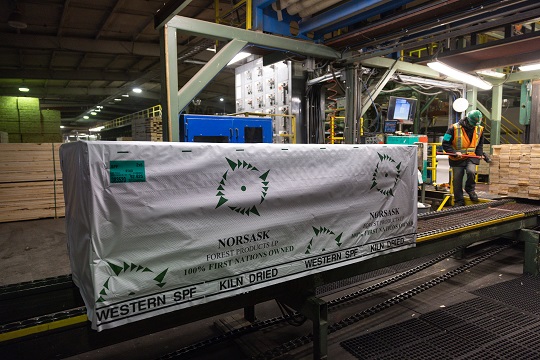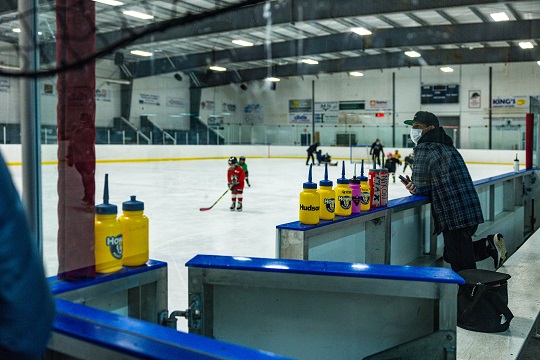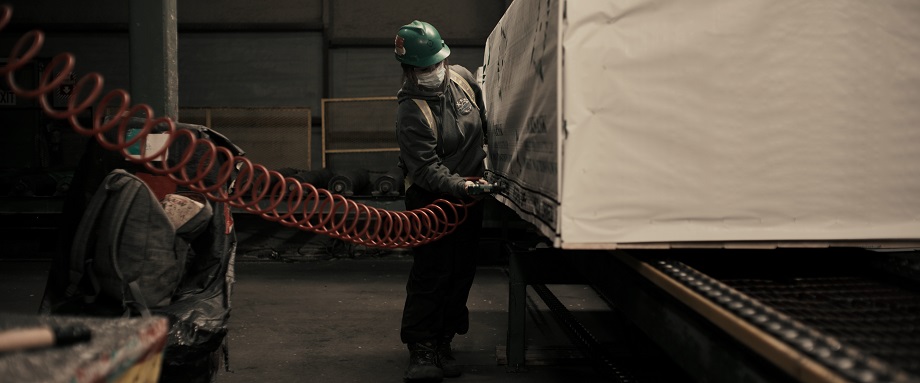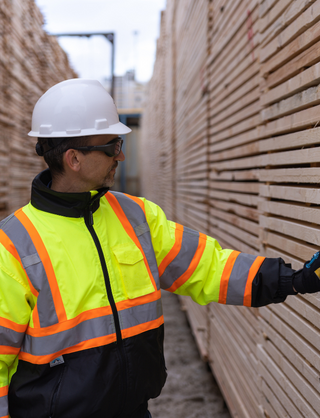When profits flow back to your community, the benefits of a successful export business go far beyond the bottom line.
Six weeks into the first COVID-19 lockdown of 2020, hundreds of thousands of remote workers sitting in their ad hoc basement or spare room home offices looked around and made what seemed like a collective decision: If this work-from-home thing lasts much longer than a few months, we’ll have to renovate.
Tradespeople were suddenly booked a year in advance, supplies of everything from drywall to nails were on backorder and the cost of lumber shot up higher than the tallest redwood. Prices for construction materials doubled, if not tripled, as supplies drastically dwindled due to port, border and factory closures.
But does this fully explain the price spike? It’s not like Canada suddenly ran out of trees. So, what happened?
Almost three years later, in his Meadow Lake Tribal Council (MLTC) office 600 kilometres from Regina in the Saskatchewan hinterland, Al Balisky chuckles.

As president and CEO of Meadow Lake Tribal Council Industrial Investments (MLTCII), an economic development corporation that generates wealth and opportunities for the MLTC’s nine-member First Nations, he has a unique perspective.
“What happened with the price of two-by-fours? That’s a very good question. It’s a complicated answer, but the short version is that lumber is sold on emotion. The pandemic created an elastic band of demand versus supply. The perception of a looming commodity shortage created a panic purchasing situation,” says Balisky.
In just one year, for example, the push-pull between supply and demand forced North American lumber prices to nearly triple, from an average of $499 per 1,000 board feet in 2019 to a staggering $1,288 in September 2020.

It’s easy to assume this price increase meant nothing but good things for lumber producers, like MLTC. But the pandemic threw up roadblocks that made it challenging for them to reap the benefits. In the early stages of the pandemic, the initial decision was to reduce sawmill operations and, like many other mills, they were forced to cut shiftwork for their 120 employees, 65% of whom are Indigenous. Fewer hours worked meant less finished lumber produced from Canadian sources—a major reason for the spike in North American lumber prices. Yet, low interest rates meant easier access to loans for renovations, and so the cycle continued.
Fast-forward to 2022, and it’s all changed again.
“We now have entered an inflationary period with rising interest rates and the housing market has cooled off,” says Balisky. “We’re constantly looking into the crystal ball and constantly getting it wrong.”

Yet, throughout the ups and downs, MLTCII’s operations have thrived. A strong export strategy that diversified their customer base has been a key driver of their success. Over the past seven years, the corporation has increased production by 25% and by March 2021, they were doing $118 million in domestic and export trade to the United States. With every sale, MLTCII generates tangible economic benefits for its First Nations communities.
As a tribal council, the MLTC’s economic prosperity and growth are directly tied to the health and well-being of its member First Nations, who have turned shared profits into everything from micro-housing and youth programs to water-treatment plants and community buildings.
Doing business with purpose
A significant part of the MLTCII’s success is access to resources, good management and financial backing from First Nations Bank of Canada, Export Development Canada (EDC) and Business Development Bank of Canada (BDC), says Sacha Munro, MLTCII’s chief financial officer.
“EDC helps us maintain operations when times are tough, and we need lending and cash flow. When markets turn and we’re not as profitable, we can still maintain operations and employment. So, when things are good, we can make distributions to our shareholders,” she says.

The shareholders are nine First Nations in northwestern Saskatchewan, who represent the interests of their 15,000 community members. As a tribal council, the MLTC’s economic prosperity and growth are directly tied to the health and well-being of its member First Nations, who have turned shared profits into everything from micro-housing and youth programs to water-treatment plants and community buildings.
Profit-sharing may sound unusual, but it’s typical for the roughly 500 Indigenous economic development corporations operating within Canada, says Todd Evans, EDC’s national lead for Indigenous exporters.
“Like MLTC, Indigenous economic development corporations are there to support their communities, create employment, provide dividend payments, and support infrastructure, like health and social programs. When you look at it, it’s like having a double bottom line: You need profit, but you also need to factor in the mandate of supporting the community with profit-sharing structures. It’s supporting the community, creating opportunities for young people, creating self-sufficiency and financial sovereignty,” Evans says.

In the case of MLTCII, a positive relationship with EDC and First Nations Bank of Canada has meant that, as other smaller, privately-owned sawmill operations were bought out by major forestry conglomerates, MLTCII was able to remain independent and even expand. In addition to now owning a specialty wood products facility, MLTCII has also focused on delivering renewable energy solutions through the MLTC Bioenergy Centre. A first for Saskatchewan, the green energy biomass project’s aim is to generate carbon-neutral green power using sawmill waste. The plant will produce 6.6 megawatts of electricity, enough to power 5,000 homes.
A tailored approach delivers the export impact
EDC’s relationship with the Meadow Lake Tribal Council began in spring 2017. That year, the federal government established a policy to encourage underrepresented groups’ participation in international trade. In 2019, EDC launched a new strategy to support Indigenous exporters. Since then, we’ve provided financial services and trade knowledge to 235 Indigenous companies and facilitated $531.2 million in business through loan guarantees, direct lending, credit insurance and bonding guarantees.
For MLTCII, EDC’s partnership with First Nations Bank of Canada resulted in a loan guarantee arrangement that supported the council’s expansion and modernization plans. EDC provided a $3-million guarantee on a $10-million loan, up to $8 million in guarantees on capital expense loans and a $750,000 reforestation bonding capacity. Leveraging First Nations Bank of Canada’s extensive knowledge and experience with Indigenous businesses allowed EDC to structure a deal to meet MLTC’s needs.
“We needed to understand their business needs, the problems they were having and what was preventing them from growing and scaling the business. We looked at bringing standard solutions to the table and tailoring them to support what they needed,” explains Randy Lott, EDC’s commercial account director in the Prairies.
To get to where the connection is now, Lott says it’s been critical “to take the time to understand the story. We need to learn and understand: What do they need and what do we need to understand about the nuances? It’s critical to understand this or you limit your ability to help them grow and expand.”
Providing access to capital for Indigenous exporters
EDC’s backing is particularly important when economic upheaval directly impacts the ability of Indigenous exporters to do business in their industries, which range from forestry and fisheries to energy, mining and tourism, says Evans.
“When there are downturns, the private sector often retreats and makes access to capital and insurance harder to get, but EDC continues to support companies through downturns and economic crises, similar to the difficulties recently experienced in the lumber industry,” he says.
“That allows their banks to have EDC support through loan guarantees. And we also continue to provide our accounts receivable insurance that helps companies maintain their cash flow.”
Many of EDC’s Indigenous business owners use the Export Guarantee Program (EGP), a flexible working capital solution that helps exporters get line of credit increases or term loans and other financial support from financial institutions. The size of the guarantee can vary, depending on the assets being financed and the size of the facility.
“The EGP gives the bank comfort that a AAA Government of Canada company is guaranteeing their loan. So, if there’s a small company that needs capital investment, EDC’s backing means a bank might increase a line of credit. With accounts receivable and credit insurance, EDC will cover 90% of any losses from sales. We call that ‘sleep at night’ insurance. That’s the neat thing about EDC’s insurance on sales. It gives peace of mind and gives lenders and banks comfort knowing that their clients’ sales are insured,” says Evans.

Growth opportunities for Indigenous businesses
With EDC’s target of helping 400 Indigenous clients and supplying them with $650 million in financial services by the end of 2023, Evans says the organization is on track to see more Indigenous exporters and indirect exporters move onto the world stage.
Although most of the 60,000 Indigenous-owned companies in Canada are small or micro firms, according to the Canadian Council for Aboriginal Business, Evans says many of them are already operating in export-oriented sectors, like resources, agri-food, manufacturing, mining and energy. Amongst those, many could also be identified as indirect exporters whose products are in the export supply chain, even if the companies themselves don’t directly sell across the border.
“There’s a steady and decent growth amongst Indigenous exporters, possibly because there’s a catchup factor as more and more take an interest in export as we raise awareness. We’re encouraging Indigenous companies to look at opportunities and benefits that come from exporting. Many are young entrepreneurs. They’re savvy, they’re looking at options and exporting is often in their business plan,” he says.
What’s next for MLTC
As the future expands for up-and-coming Indigenous exporters, back in northwestern Saskatchewan, MLTC is looking ahead to another export challenge, this one related to ongoing discussions between Canada and the U.S. related to softwood lumber. Until an agreement is in place, tariffs paid on MLTC finished lumber will continue increasing.
While MLTC awaits a resolution, Al Balisky offers insight for young Indigenous entrepreneurs when it comes to dealing with EDC and First Nations Bank of Canada.
“We have a direct connection with the people. We have trusted long-term relationships,” he says. “These are friends.”
Creating new paths to prosperity
EDC recognizes that growing the Indigenous economy is a cornerstone of reconciliation. Bringing Indigenous products and services to new markets creates sustainable, resilient economic opportunities for future generations. We’re committed to removing barriers to trade for Indigenous economic development corporations and entrepreneurs looking to grow internationally. Visit edc.ca/indigenous-business to learn more, or call us at 1-800-229-0575.





